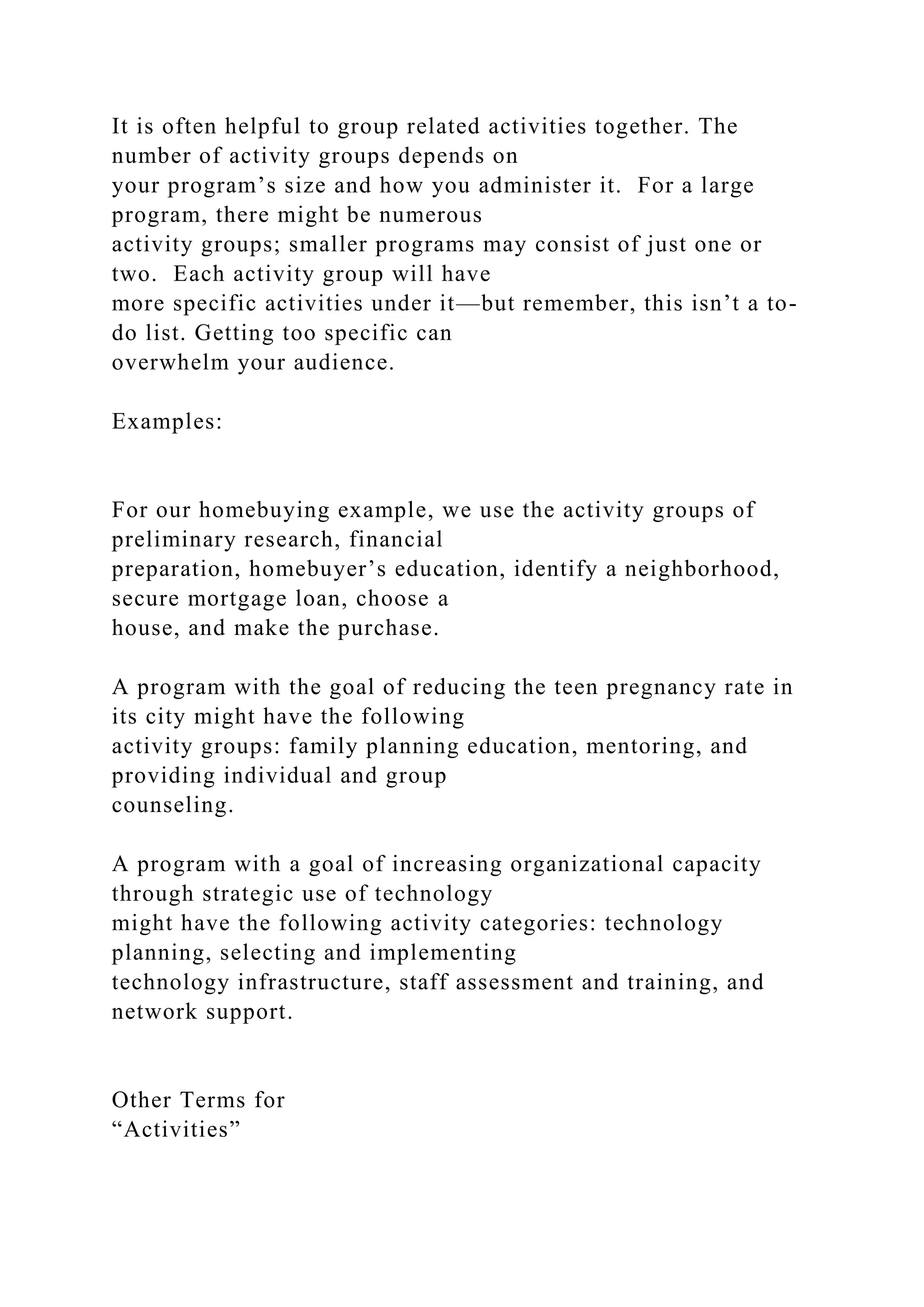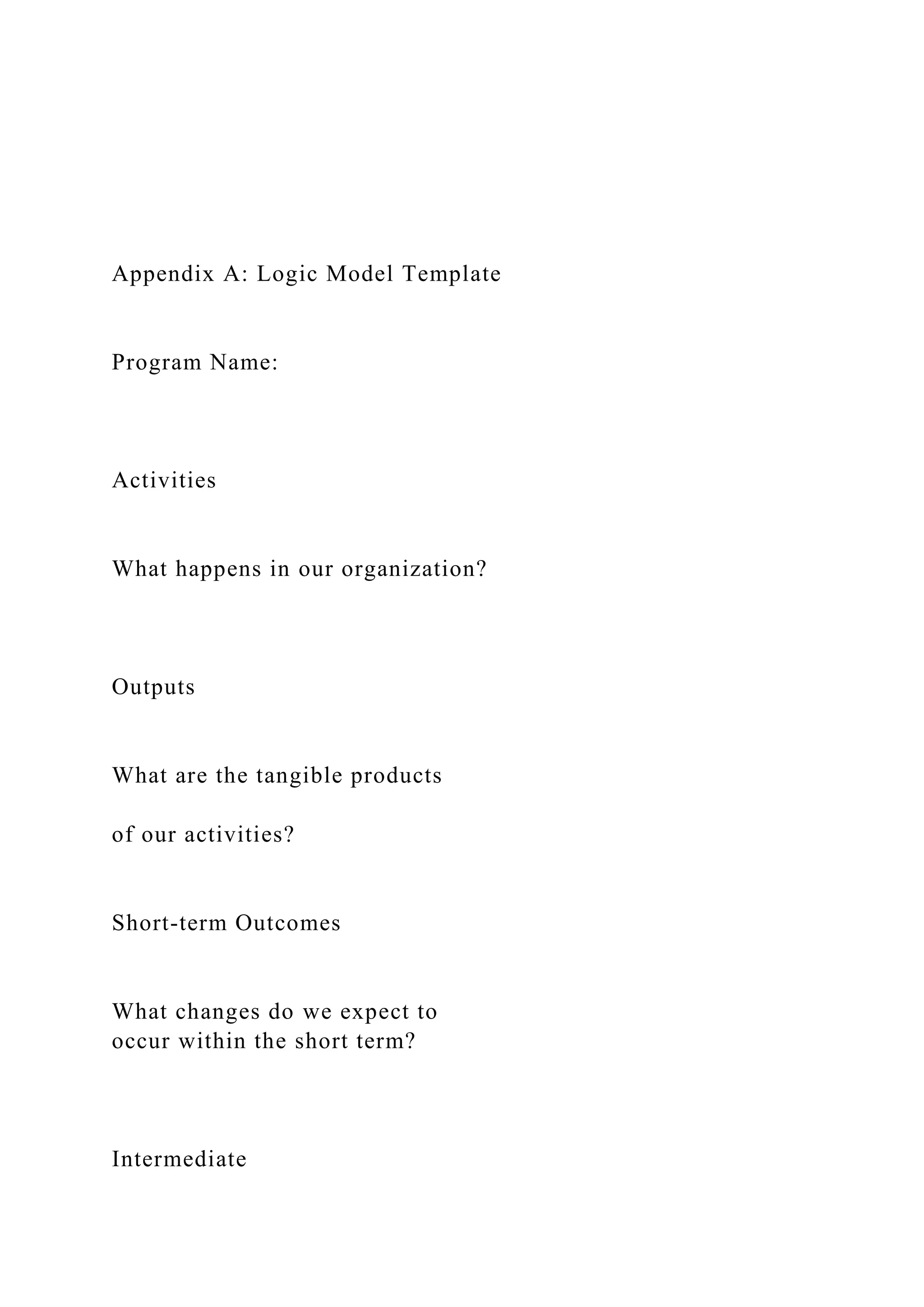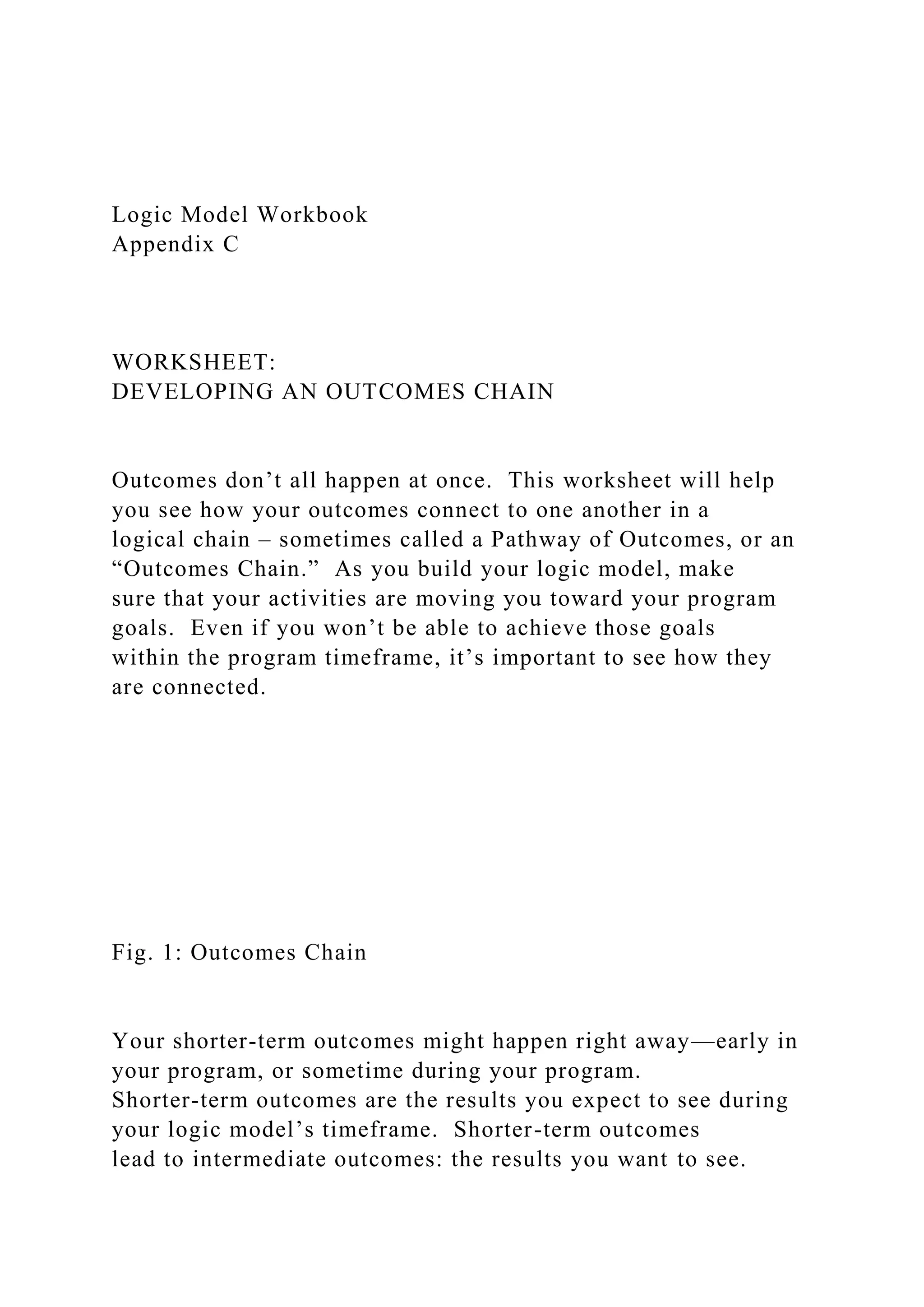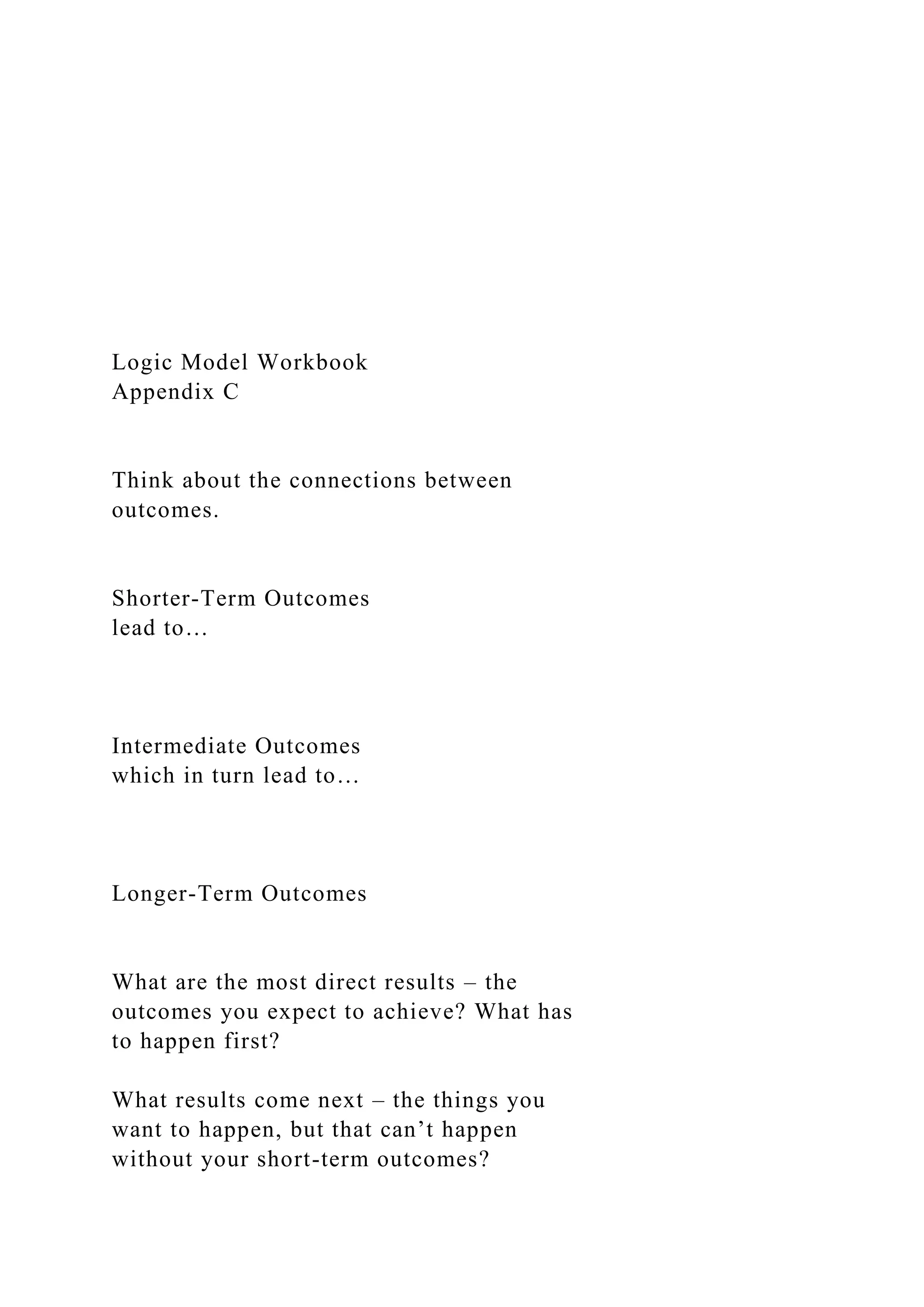This document provides guidance on developing a logic model through a step-by-step process. It explains that a logic model clarifies and depicts a program by showing the resources, activities, outputs, and outcomes in a visual way. The document then walks through each component of a logic model, providing examples and tips for developing problem statements, goals, rationales, resources, activities, outputs, and outcomes. It emphasizes that a logic model establishes a logical framework or theory of change and serves as a foundation for program planning and evaluation.
![I N N O V A T I O N N E T W O R K , I N C .
www.innonet.org • [email protected]
L o g i c M o d e l W o r k b o o k
I N N O V A T I O N N E T W O R K , I N C .
www.innonet.org • [email protected]
L o g i c M o d e l W o r k b o o k
T a b l e o f C o n t e n t s
P a g e
Introduction - How to Use this Workbook
.....................................................................2
Before You Begin
...............................................................................................
..................3
Developing a Logic Model
...............................................................................................
..4](https://image.slidesharecdn.com/innovationnetworkinc-221015121252-b2177df4/75/I-N-N-O-V-A-T-I-O-N-N-E-T-W-O-R-K-I-N-C-www-innone-docx-1-2048.jpg)

![Logic Model Review
...............................................................................................
............18
Appendix A: Logic Model Template
Appendix B: Worksheet: Developing an Outcomes Chain
Logic Model Workbook
Page 2
I N N O V A T I O N N E T W O R K , I N C .
www.innonet.org • [email protected]
I n t r o d u c t i o n - H o w t o U s e t h i s W o r k b o o k
Welcome to Innovation Network’s Logic Model Workbook. A
logic model is a commonly-used
tool to clarify and depict a program within an organization. You
may have heard it described as
a logical framework, theory of change, or program matrix—but
the purpose is usually the same:
to graphically depict your program, initiative, project or even
the sum total of all of your
organization’s work. It also serves as a
foundation for program planning and
evaluation.
This workbook is a do-it-yourself guide to
the concepts and use of the logic model. It](https://image.slidesharecdn.com/innovationnetworkinc-221015121252-b2177df4/75/I-N-N-O-V-A-T-I-O-N-N-E-T-W-O-R-K-I-N-C-www-innone-docx-3-2048.jpg)

![This checklist icon appears at points in the workbook at which
you should record
something – either write something in your template, or enter it
into your online Logic Model
Builder.
Why evaluate?
Evaluation serves many purposes:
• Supports program and strategic
planning
• Helps communicate your goals and
progress
• Serves as a basis for ongoing learning
to make your work stronger and
more effective.
http://www.innonet.org/�
Logic Model Workbook
Page 3
I N N O V A T I O N N E T W O R K , I N C .
www.innonet.org • [email protected]
Ongoing Learning Cycle](https://image.slidesharecdn.com/innovationnetworkinc-221015121252-b2177df4/75/I-N-N-O-V-A-T-I-O-N-N-E-T-W-O-R-K-I-N-C-www-innone-docx-5-2048.jpg)

![• This logic model structure is intended for program planning.
Define the parameters of
your program clearly. If your organization is small and only
has one program, you can
also use this structure for small-scale strategic planning.
Logic Model Workbook
Page 4
I N N O V A T I O N N E T W O R K , I N C .
www.innonet.org • [email protected]
D e v e l o p i n g a L o g i c M o d e l
Many different logic model formats exist, but they all contain
the same core concepts. The
format we use in this workbook and in our online tools has
proven useful and manageable for
the nonprofit partners we have worked with, and is the result of
more than fifteen years of
program planning and evaluation experience in the field.
It’s not necessary to create your logic model all in one sitting.
It will almost certainly be useful
to talk to other program stakeholders and get their input along
the way. You can work through
the process as we have it laid out here – starting with the
problem your program is meant to
solve, and ending with your intended outcomes – or, if it’s
easier for you, you can work in
reverse, starting with outcomes and working your way](https://image.slidesharecdn.com/innovationnetworkinc-221015121252-b2177df4/75/I-N-N-O-V-A-T-I-O-N-N-E-T-W-O-R-K-I-N-C-www-innone-docx-7-2048.jpg)
![backwards.
Similarly, the names of key components may also vary among
different logic models used in the
field, but the underlying concepts are the same. In this
workbook, we identify other terms used
in the field for similar concepts. As you develop your logic
model, we encourage you to find a
common language to use among key stakeholders, whether that
language reflects the terms
used here or elsewhere. The important thing is that everyone
involved uses the same terms.
The components of the logic model used by Innovation Network
are:
Logic Model Workbook
Page 5
I N N O V A T I O N N E T W O R K , I N C .
www.innonet.org • [email protected]
A series of “if-then” relationships connect the components of
the logic model: if resources are
available to the program, then program activities can be
implemented; if program activities are
implemented successfully, then certain outputs and outcomes
can be expected.](https://image.slidesharecdn.com/innovationnetworkinc-221015121252-b2177df4/75/I-N-N-O-V-A-T-I-O-N-N-E-T-W-O-R-K-I-N-C-www-innone-docx-8-2048.jpg)


![I N N O V A T I O N N E T W O R K , I N C .
www.innonet.org • [email protected]
T h e L o g i c M o d e l ’ s R o l e i n E v a l u a t i o n
The cornerstone of effective evaluation is a thorough
understanding of the program you are
trying to evaluate: What resources it has to work with, what it is
doing, what it hopes to
achieve, for whom, and when. In conducting an evaluation, it is
tempting to focus most of your
attention on data collection. However, your evaluation efforts
will be more effective if you start
with a logic model. Going through the logic model process will
help ensure that your
evaluation will yield relevant, useful information.
The figure below illustrates how the logic model you will build
can serve as the foundation for
future evaluation plans. (Our Evaluation Plan Workbook and
online Evaluation Plan Builder offer
guidance for creating evaluation plans.)
Logic Model
Evaluation Plan:
Process
OutputsActivities Outcomes
OutputsActivities
Evaluation Plan:
Outcomes](https://image.slidesharecdn.com/innovationnetworkinc-221015121252-b2177df4/75/I-N-N-O-V-A-T-I-O-N-N-E-T-W-O-R-K-I-N-C-www-innone-docx-11-2048.jpg)

![called an "issue statement" or "situation."
Logic Model Workbook
Page 7
I N N O V A T I O N N E T W O R K , I N C .
www.innonet.org • [email protected]
Your problem statement should briefly explain what needs to
change: why is there is a need for
an intervention? Your problem statement answers the question,
“What problem are we working
to solve?” Include “who, what, why, where, when, and how” in
your statement.
Sample problem statements:
I do not own my own home, so I do not experience the many
financial and emotional
benefits of home ownership.
A growing number of women in Highland Falls lack the
confidence and know-how to
obtain employment and be self-sufficient due to low literacy in
our region.
In Townsville, low-income residents with bad or no credit do
not have resources available
to help them improve their current living situations.
Build Your Logic Model: When you have identified your
problem statement, insert it into
the Problem Statement box in your logic model template, or on](https://image.slidesharecdn.com/innovationnetworkinc-221015121252-b2177df4/75/I-N-N-O-V-A-T-I-O-N-N-E-T-W-O-R-K-I-N-C-www-innone-docx-13-2048.jpg)

![Improve the health status of children, ages birth to 8 years, in
Harrison County.
Other Terms for
“Goal”
You might also hear a goal called an
"objective" or a "long-term outcome."
Logic Model Workbook
Page 8
I N N O V A T I O N N E T W O R K , I N C .
www.innonet.org • [email protected]
Goal Tips:
• All logic model components should be connected to your goal.
Having a clear goal helps
fight the temptation to implement an interesting program that
doesn’t really “fit.”
• It’s tempting to have more than one goal, but we recommend
that you articulate one clear
solution to your problem statement. Other goals of your
program may be long-term
outcomes, rather than goals.
• Phrase your goal in terms of the change you want to achieve
over the life of your](https://image.slidesharecdn.com/innovationnetworkinc-221015121252-b2177df4/75/I-N-N-O-V-A-T-I-O-N-N-E-T-W-O-R-K-I-N-C-www-innone-docx-15-2048.jpg)

![These rationales all demonstrate a core set of beliefs based on
knowledge about how changes
occur in the field.
Build Your Logic Model: If you choose to include Rationales
in your logic model, record
them in the “Rationales” box on the template, or on the
“Rationale/Assumptions” tab in the
online Logic Model Builder.
http://www.innonet.org/?module=lmb.rationales&set_v=d3BfaW
Q9MjEwJmxtYl9kYXRhX3R5cGVfaWQ9MyZsbWJfZGF0YV9p
ZD0yMjU5Jm1vZGU9ZWRpdF9sbWJfZGF0YQ==�
http://www.innonet.org/?module=lmb.rationales&set_v=d3BfaW
Q9MjEwJmxtYl9kYXRhX3R5cGVfaWQ9MyZsbWJfZGF0YV9p
ZD0yMjU5Jm1vZGU9ZWRpdF9sbWJfZGF0YQ==�
Logic Model Workbook
Page 9
I N N O V A T I O N N E T W O R K , I N C .
www.innonet.org • [email protected]
Assumptions
The assumptions that underlie a program’s theory are conditions
that are necessary for success,
and you believe are true. Your program needs these conditions
in order to succeed, but you
believe these conditions already exist – they are not something
you need to bring about with](https://image.slidesharecdn.com/innovationnetworkinc-221015121252-b2177df4/75/I-N-N-O-V-A-T-I-O-N-N-E-T-W-O-R-K-I-N-C-www-innone-docx-17-2048.jpg)

![Resources
Identify the available resources for your program. This
helps you determine the extent to which you will be
able to implement the program and achieve your
intended goals and outcomes.
List the resources that you currently have to support
your program. (If you intend to raise additional resources for
the program during this program
timeframe, account for them under "Activities.")
An exception: If you’re building your logic model as part of a
proposal or to justify a funding
request, list all the resources you will need for a successful
program, whether or not you have
them in hand. (You may wish to separate resources under
headings for “need” and “have.”)
Other Terms for
“Resources”
You might also hear resources called
“inputs” or “program investments”.
Logic Model Workbook
Page 10
I N N O V A T I O N N E T W O R K , I N C .
www.innonet.org • [email protected]
Common types of resources include:](https://image.slidesharecdn.com/innovationnetworkinc-221015121252-b2177df4/75/I-N-N-O-V-A-T-I-O-N-N-E-T-W-O-R-K-I-N-C-www-innone-docx-19-2048.jpg)


![Build Your Logic Model: List your resources statement(s) in
the Resources box in your
logic model template, or on the “Timeframe/Resources” tab of
the online Logic Model Builder.
Logic Model Workbook
Page 11
I N N O V A T I O N N E T W O R K , I N C .
www.innonet.org • [email protected]
Activities
Activities are the actions that are needed to implement
your program—what you will do with program
resources in order to achieve program outcomes and,
ultimately, your goal(s).
Common activities are:
• Developing products (e.g., promotional materials and
educational curricula),
• Providing services (e.g., education and training, counseling or
health screening),
• Engaging in policy advocacy (e.g., issuing policy statements,
conducting public
testimony), or
• Building infrastructure (e.g., strengthening governance and
management structures,
relationships, and capacity).](https://image.slidesharecdn.com/innovationnetworkinc-221015121252-b2177df4/75/I-N-N-O-V-A-T-I-O-N-N-E-T-W-O-R-K-I-N-C-www-innone-docx-22-2048.jpg)

![You might also hear activities called
“processes,” “strategies,” “methods,” or
“action steps.”
Logic Model Workbook
Page 12
I N N O V A T I O N N E T W O R K , I N C .
www.innonet.org • [email protected]
Activities Tips:
• You can use the activities you identify here as an outline for a
work plan. Use the
activities as headings in a more comprehensive work plan that
includes staff
assignments and a timeline.
• Providing a complete list of activities helps people who are
not familiar with your
understand what it really takes to implement it—but getting too
specific can overwhelm
them. The chart below gives some examples of what level of
specificity is useful.
Activity Group: Identify a neighborhood
ACTIVITIES:
• Hire real-estate agent
• Drive around the city](https://image.slidesharecdn.com/innovationnetworkinc-221015121252-b2177df4/75/I-N-N-O-V-A-T-I-O-N-N-E-T-W-O-R-K-I-N-C-www-innone-docx-24-2048.jpg)

![This is just about the right level of detail for a logic
model.
Build Your Logic Model: List all activities required to
implement your program, and
group related activities together. Record them in your template
or on the “Activities/Outputs”
tab of the online Logic Model Builder.
Logic Model Workbook
Page 13
I N N O V A T I O N N E T W O R K , I N C .
www.innonet.org • [email protected]
Outputs
Outputs are the measurable, tangible, and direct products
or results of program activities. They lead to desired
outcomes—benefits for participants, families,
communities, or organizations—but are not themselves the
changes you expect the program will produce. They do
help you assess how well you are implementing the
program.
Whenever possible, express outputs in terms of the size and/or
scope of services and products
delivered or produced by the program. They frequently include
quantities or reflect the
existence of something new.](https://image.slidesharecdn.com/innovationnetworkinc-221015121252-b2177df4/75/I-N-N-O-V-A-T-I-O-N-N-E-T-W-O-R-K-I-N-C-www-innone-docx-26-2048.jpg)

![template or on the
“Activities/Outputs” tab of the online Logic Model Builder.
Other Terms for
“Outputs”
You might also hear outputs called
“deliverables,” “units of service,” or
“products.”
Logic Model Workbook
Page 14
I N N O V A T I O N N E T W O R K , I N C .
www.innonet.org • [email protected]
Outcomes
Outcomes express the results that your program intends to
achieve if implemented as planned. Outcomes are the
changes that occur or the difference that is made for
individuals, groups, families, organizations, systems, or
communities during or after the program.
Outcomes answer the questions: “What difference does the
program make? What does success
look like?” They reflect the core achievements you hope for
your program.
Outcomes should:
• Represent the results or impacts that occur because of program](https://image.slidesharecdn.com/innovationnetworkinc-221015121252-b2177df4/75/I-N-N-O-V-A-T-I-O-N-N-E-T-W-O-R-K-I-N-C-www-innone-docx-28-2048.jpg)

![o Changed policies
For example:
• Potential homeowners have purchased their first home.
• Teens ages 15-18 participate in community service.
Other Terms for
“Outcomes”
You might also hear outcomes called
“results”, “impacts”, or “objectives”.
Logic Model Workbook
Page 15
I N N O V A T I O N N E T W O R K , I N C .
www.innonet.org • [email protected]
Changes in Condition:
o Human (e.g., from oppression to freedom; from
malnourishment to food
security)
o Economic (e.g., from unemployed to employed)
o Civic (e.g., from disenfranchised to empowered)
o Environmental (e.g., from polluted to clean)
For example:
• Potential homeowners have purchased their first home.
• Teens ages 15-18 have improved employment prospects](https://image.slidesharecdn.com/innovationnetworkinc-221015121252-b2177df4/75/I-N-N-O-V-A-T-I-O-N-N-E-T-W-O-R-K-I-N-C-www-innone-docx-30-2048.jpg)

![systems and might include cases where
agencies, departments, or complex organizations work in new
ways, behave differently, share
resources, and provide services in a coordinated fashion.
Examples include:
• Integrated system of services or interagency resource sharing
• Greater coordination among partners in a system
4. Organizational Outcomes: Some programs lead to internal
outcomes—both individual and
institutional—that affect how well a program can achieve
external outcomes. These produce
improvements in program management and organizational
effectiveness. Examples of
organizational outcomes include:
• Increased efficiency
• Increased staff motivation
• Increased collaboration with other organizations
Logic Model Workbook
Page 16
I N N O V A T I O N N E T W O R K , I N C .
www.innonet.org • [email protected]
Chain of Outcomes. Not all outcomes can occur at the same
time. Some outcomes must occur
before others become possible. This is referred to as the “chain
of outcomes.” (See Appendix B
for a worksheet.)](https://image.slidesharecdn.com/innovationnetworkinc-221015121252-b2177df4/75/I-N-N-O-V-A-T-I-O-N-N-E-T-W-O-R-K-I-N-C-www-innone-docx-32-2048.jpg)


![More Attributable to Program
Long-Term
CONDITION: The conditions
that change as a result of
those actions.
• Increased number of
children of targeted
parents who continue to
receive up to date
immunizations
• Fewer children suffering
from preventable
childhood diseases
• Better overall health for
children
More Distant in Time
Harder to Measure
Less Attributable to Program
Logic Model Workbook
Page 17
I N N O V A T I O N N E T W O R K , I N C .
www.innonet.org • [email protected]
Outcomes vs. Outputs
Since outcomes are sometimes confused with outputs, we’d like](https://image.slidesharecdn.com/innovationnetworkinc-221015121252-b2177df4/75/I-N-N-O-V-A-T-I-O-N-N-E-T-W-O-R-K-I-N-C-www-innone-docx-35-2048.jpg)


![in the “short-term” box
• Place the outcomes you want to see over more time in the
“intermediate” box
• Place the outcomes you hope to see eventually in the “long-
term” box.
Logic Model Workbook
Page 18
I N N O V A T I O N N E T W O R K , I N C .
www.innonet.org • [email protected]
L o g i c M o d e l R e v i e w
Once your logic model is complete, take time to revisit and
review your work. Consider the
following questions:
• Does your organization have adequate resources to implement
the activities and achieve
the desired outcomes? If you need further resources, is that
reflected in your activities?
• Have you included all the major activities needed to
implement your program and
achieve expected outcomes? Would the activities list enable
someone who is unfamiliar
with your program to understand its scope?
• Have you expressed your outcomes in terms of change? Have](https://image.slidesharecdn.com/innovationnetworkinc-221015121252-b2177df4/75/I-N-N-O-V-A-T-I-O-N-N-E-T-W-O-R-K-I-N-C-www-innone-docx-38-2048.jpg)

![• Use it to tell your story to potential clients, donors, and
media.
• Use it to evaluate your work – a sound logic model is the
foundation of effective
evaluation.
Innovation Network provides several resources to help you
develop evaluation plans. In
addition to our in-person training, we offer an Evaluation Plan
Builder and an evaluation
workbook through the Point K Learning Center
(www.innonet.org/pointk; free registration is
required).
http://www.innonet.org/pointk�
Logic Model Workbook
Page 19
I N N O V A T I O N N E T W O R K , I N C .
www.innonet.org • [email protected]
T h a n k y o u f o r y o u r i n t e r e s t !
We hope this workbook has been valuable to you and that you’ll
continue to use it as a
reference for your program logic models.
If you have any questions about program planning or evaluation,
or are interested in our in-
person services (including logic model review services), please
visit our website,
www.innonet.org or contact us at:](https://image.slidesharecdn.com/innovationnetworkinc-221015121252-b2177df4/75/I-N-N-O-V-A-T-I-O-N-N-E-T-W-O-R-K-I-N-C-www-innone-docx-40-2048.jpg)

![http://www.innonet.org/�
mailto:[email protected]�
http://www.innonet.org/�
http://creativecommons.org/licenses/by-nc-sa/3.0/us/�
http://creativecommons.org/licenses/by-nc-sa/3.0/us/�
Appendix A: Logic Model Template
Program Name:
PROBLEM STATEMENT:
PROGRAM GOAL (S):
Resources
What resources do we have to work with?
Activities
What happens in our organization?
Outputs](https://image.slidesharecdn.com/innovationnetworkinc-221015121252-b2177df4/75/I-N-N-O-V-A-T-I-O-N-N-E-T-W-O-R-K-I-N-C-www-innone-docx-42-2048.jpg)









